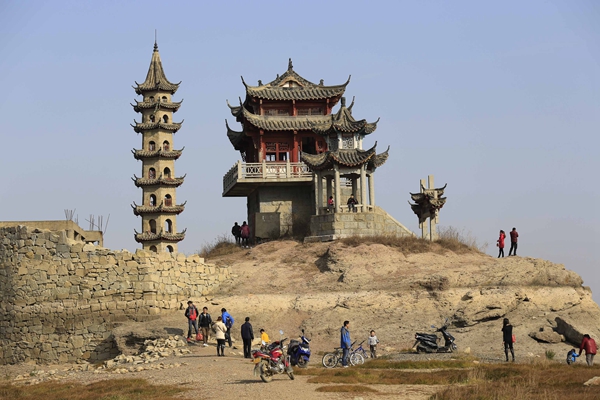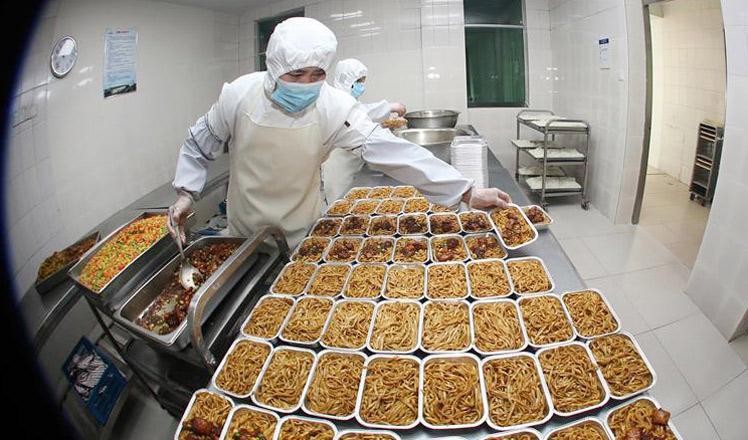A thirst for change in polluted waterways
Updated: 2016-01-29 11:25
(China Daily)
|
||||||||
 |
|
Visitors can visit a scenic spot in Poyang Lake, Jiangxi province, by foot and bike because of the falling water level in the lake.[Photo/CHINA DAILY] |
Northern Hebei province is faced with the country's biggest water crisis. It has one-seventh the national average of per capita water resources, with just 307 cubic meters.
"The province has 6 billion cubic meters of overexploited underground water out of the country's total 17 billion cubic meters," said Qi Bingqiang, an official with the Ministry of Water Resources.
In 2006, an 8-kilometer-long sinkhole suddenly appeared in Baixiang county, Hebei. Experts linked the sudden collapse to drought and falling levels of underground water.
"The gap grew wider and wider, with the widest spot about 1 meter. You could hardly see the bottom," said Zhai Jingli, a resident of nearby Zhailixi village.
Cracks not only appeared on the ground, but also in homes. More than 230 of the 420 houses in the village have cracked walls because the foundations have shifted. Cracks have formed on the ceilings, walls and floor throughout villager Lu Haisu's house.
"We rebuilt the house twice after it started to crack in 2006, but the cracks kept showing up again after the reconstruction," the 54-year-old said. "I can hear the wall cracking at night when I'm in bed."
Water shortages also plague nearby Beijing. The capital's average annual rainfall of 500 millimeters can only provide water for a population of 12 million people, but in 2011 the city's population had reached 20 million, according to the municipal water authorities.
"Even after receiving water from the south-north water diversion project, Beijing still partly relies on the exploitation of underground water to meet its needs," said Xu Xinxuan, head of the Water Sciences Institute at Beijing Normal University.
In southern provinces, the water level is falling in several lakes, including Dongting Lake in Hunan province, and Poyang Lake in Jiangxi province. Experts believe the shortage is spreading from north to south.
Conservation projects
Even without the pressures exerted by industrialization, China's water situation is cause for concern. The nation's water resources are just 27 percent of the global average and are unevenly distributed. Floods and droughts are common.
But the country is making efforts to conserve its water resources and fight pollution. Between 2011 and last year, 238 billion yuan ($36 billion) was spent on water-conservation projects in poor areas, according to the ministry.
In April, a detailed action plan aimed at improving the quality of drinking water and promoting water conservation was introduced.
According to the plan, annual pollution checks will be included in performance reviews for provincial officials. Distribution of funds for the campaign will also depend on the results.
From next year, a blacklist will name businesses that exceed their water pollution quotas, with severe violators risking closure.
The plan also stipulates that more than 70 percent of the water in the seven major river valleys, including the Yangtze and Yellow rivers, should be in good condition by 2020. The same target has been set for offshore areas.
Next year will also herald the beginning of 20 major water projects, and 172 key water projects will be pushed forward in the coming five years, according to Chen Lei, minister of water resources.
A multi-tier pricing system has been launched in 321 cities across 29 provinces and regions, allowing the price of water to reflect local conditions.
However, experts point out the system is not strict enough in some cities. In many areas, the price increase is only felt by those with limited incomes and few people feel the need to save water.
Zhu Dangsheng, chief engineer at the ministry's China Renewable Energy Engineering Institute, said cities and areas that share rivers or lakes must coordinate their actions to resolve the problem.
As one of 13 major grain suppliers in the country, about 70 percent of Hebei's underground water is used for irrigation, but according to one local official, who preferred not to be named, there are competing claims for resources.
"The central government has invested a huge amount of money to save underground water and protect the ecosystem in Hebei province.
But at the same time, the agriculture department is pushing for higher grain output. With Hebei's serious water problem, the agricultural department should lower the designated grain output in those cities and counties that suffer most," he said.
- Students must learn safety education, experts say
- 73 bodies recovered from rubble of Shenzhen landslide
- Chinese travelers lead 2015 global outbound tourism
- S Korea to issue 10-year visa to highly-educated Chinese tourists
- A glimpse of Spring Rush: little migrant birds on the way home
- Policy puts focus on genuine artistic students
- Goodwill sets tone at Wang, Kerry's briefing
- Obama picks new Afghan commander
- Ceremony held in Auschwitz Camp to remember the Holocaust
- Thousands of beckoning cat on display in Japan's Goutoku Temple
- Chinese fishing boat capsizes off S. Korean island: Yonhap
- 42 cases of Zika infection reported in N.E. Panama

 Top 10 best selling cars on Chinese mainland 2015
Top 10 best selling cars on Chinese mainland 2015
 Warm memories in the cold winter
Warm memories in the cold winter
 The world's highest library
The world's highest library
 In-flight meal prepared for travel rush ahead of Spring Festival
In-flight meal prepared for travel rush ahead of Spring Festival
 72-year-old teaches yoga for free in Hangzhou
72-year-old teaches yoga for free in Hangzhou
 Sea ice traps boats as cold wave sweeps across East China
Sea ice traps boats as cold wave sweeps across East China
 10 tourists grab free money in one minute in East China
10 tourists grab free money in one minute in East China
 Warm colors at sunrise cast off the chill in Qingdao
Warm colors at sunrise cast off the chill in Qingdao
Most Viewed
Editor's Picks

|

|

|

|

|

|
Today's Top News
National Art Museum showing 400 puppets in new exhibition
Finest Chinese porcelains expected to fetch over $28 million
Monkey portraits by Chinese ink painting masters
Beijing's movie fans in for new experience
Obama to deliver final State of the Union speech
Shooting rampage at US social services agency leaves 14 dead
Chinese bargain hunters are changing the retail game
Chinese president arrives in Turkey for G20 summit
US Weekly

|

|







